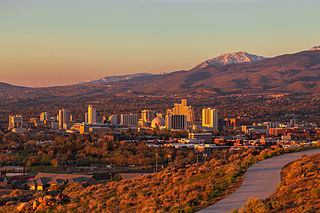
Reno is a city in the northwest section of the U.S. state of Nevada, along the Nevada–California border. It is the county seat and most populous city of Washoe County. Sitting in the High Eastern Sierra foothills, in the Truckee River valley, on the eastern side of the Sierra Nevada, it is about 23 miles (37 km) northeast of Lake Tahoe. Known as "The Biggest Little City in the World", Reno is the 80th most populous city in the United States, the fourth most populous city in Nevada, and the most populous in Nevada outside the Las Vegas Valley. The city had a population of 264,165 at the 2020 census.

Washoe County is a county in the U.S. state of Nevada. As of the 2020 census, the population was 486,492, making it Nevada's second-most populous county. Its county seat is Reno. Washoe County is included in the Reno, NV Metropolitan Statistical Area.

Fallon is a city in Churchill County in the U.S. state of Nevada. The population was 9,327 at time of the 2020 census. Fallon is the county seat of Churchill County and is located in the Lahontan Valley. Fallon is known for being home to Naval Air Station Fallon, located southeast of town.

The University of Nevada, Reno is a public land-grant research university in Reno, Nevada, United States. It is the state's flagship public university and primary land grant institution. It was founded on October 12, 1874, in Elko, Nevada.

Ormsby County was a county in Nevada Territory from 1861 to 1864 and in the State of Nevada from 1864 until 1969. It contained Carson City, the county seat, and later, the state capital, founded two years earlier.

Verdi is a census-designated place (CDP) in Washoe County, Nevada, United States. It is on the western side of the Reno–Sparks Metropolitan Statistical Area, near Interstate 80 and stretches eastward towards its neighborhood-exclave of Lawton, Nevada surrounded by Reno, Nevada west of Mae Anne Avenue. The CDP of Verdi, California lies immediately adjacent across the state line. Both are in the shadow of California's Verdi Range. In 2010, the population was 1,415. Prior to 2010, the community was listed by the U.S. Census Bureau as part of the Verdi-Mogul CDP.
Desert Research Institute (DRI) is a nonprofit research campus of the Nevada System of Higher Education (NSHE) and a sister property of the University of Nevada, Reno (UNR), the organization that oversees all publicly supported higher education in the U.S. state of Nevada. At DRI, approximately 500 research faculty and support staff engage in more than $50 million in environmental research each year. DRI's environmental research programs are divided into three core divisions and two interdisciplinary centers. Established in 1988 and sponsored by AT&T, the institute's Nevada Medal awards "outstanding achievement in science and engineering".
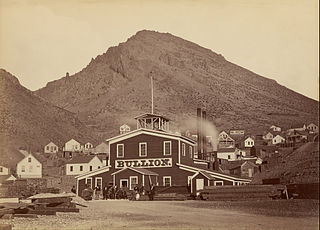
The Virginia Range is a mountain range of western Nevada, primarily within Storey County, and extending east into Lyon County. The range is named after James Finney, "Old Virginny", an early discoverer of gold associated with the Comstock Lode.

Frederic Joseph DeLongchamps was an American architect. He was one of Nevada's most prolific architects, yet is notable for entering the architectural profession with no extensive formal training. He has also been known as Frederick J. DeLongchamps, and was described by the latter name in an extensive review of the historic importance of his works which led to many of them being listed on the U.S. National Register of Historic Places in the 1980s.

Truckee Meadows Community College (TMCC) is a public community college and technical college in the Truckee Meadows of Reno, Nevada. The college is primarily a commuter campus with 5 locations. TMCC offers students both certificate and associate degrees. In 2015, TMCC was approved to offer two Bachelor of Applied Science degrees, one in Logistics Operations Management and the other in Emergency Management and Homeland Security.
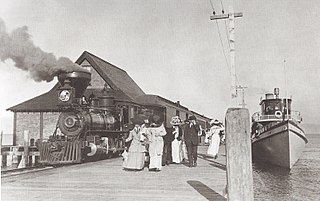
SS Tahoe was a steamship that operated on Lake Tahoe at the end of the 19th century and the first half of the 20th. Scuttled in 1940, the wreck presently lies in 400 feet (120 m) of water off Glenbrook, Nevada. The wreck was first visited in 2002 by a team from New Millennium Dive Expeditions (NMDE) in a record-setting high-altitude dive for Lake Tahoe. As a result of the work that NMDE did on the Tahoe site from 1999 up to their dives in 2002, Tahoe became the first maritime site in Nevada to be listed in the National Register of Historic Places.
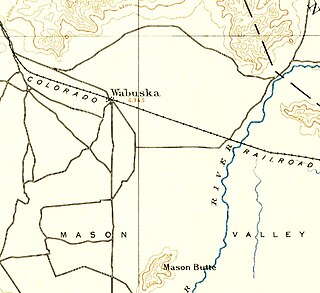
Wabuska is an unincorporated community in Lyon County, Nevada, United States. The zip code is 89447, which it shares with nearby Yerington.
The Mackay School of Earth Sciences and Engineering is a specialized school within the University of Nevada, Reno. It is named after John Mackay, father of Clarence Mackay.
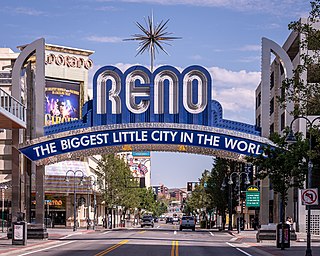
The Reno Arch is an iconic landmark in Reno, Nevada spanning Virginia Street at the intersection with Commercial Row. The current sign is the third version of the arch. It is owned and operated by the City of Reno. The original arch was built on October 23, 1926 to commemorate the completion of the Lincoln and Victory Highways. The current arch was installed on August 8, 1987, retrofitted with new lights on November 17, 2009 and had its design scheme revised to blue and silver on May 3, 2018. The arch is a prominent feature of downtown Reno and for most of its history has featured the city's motto, The Biggest Little City in the World.
Golden Valley is a census-designated place (CDP) in Washoe County, Nevada, United States. The population was 1,556 at the 2010 census. It is a northern suburb of the city of Reno and is part of the Reno–Sparks Metropolitan Statistical Area. Prior to 2010, it was listed by the U.S. Census Bureau as part of the Lemmon Valley–Golden Valley CDP.

The Washoe Valley is a geographical region in the United States covering 66 square miles (170 km2) in southern Washoe County in the state of Nevada. Located between Reno and Carson City, it is named for the Washoe people, Native Americans who lived there before the arrival of Europeans. Slide Mountain and Mount Rose overlook the valley from the west.

The Stewart Indian School (1890–1980) was an American Indian boarding school southeast of Carson City, Nevada. Today, it is the Stewart Indian School Cultural Center and Museum.
The University of Nevada, Reno School of Medicine is an academic division of the University of Nevada, Reno and grants the Doctor of Medicine (MD) degree. The School of Medicine was founded on March 25, 1969, as the first medical school in the state of Nevada. More than 2,600 MDs have graduated from the School of Medicine. The pre-clinical campus is located in Reno, but the third and fourth years can be spent in hospitals and clinics throughout Nevada. Residencies associated with the School of Medicine are located in Reno. Students may earn the MD-MPH, MD-MBA or MD–PhD degrees as well.
Edward Parsons (1907–1991) was an American architect who practiced in Nevada and was a leader in historic preservation. He was born in Tonopah, Nevada in 1907, went to school in Salt Lake City, Utah and in Reno, Nevada, and studied architecture at University of Southern California and the University of Pennsylvania.
The following is a timeline of the history of the city of Reno, Nevada, United States.
















